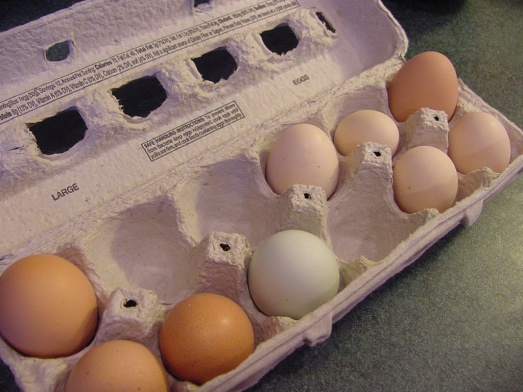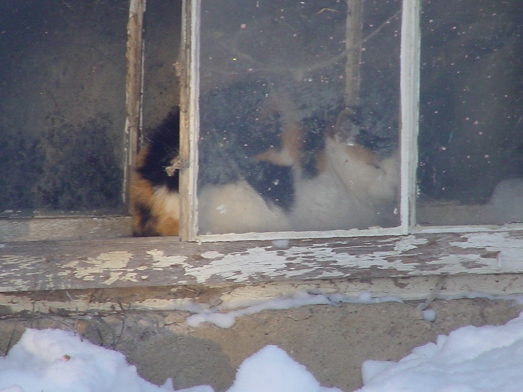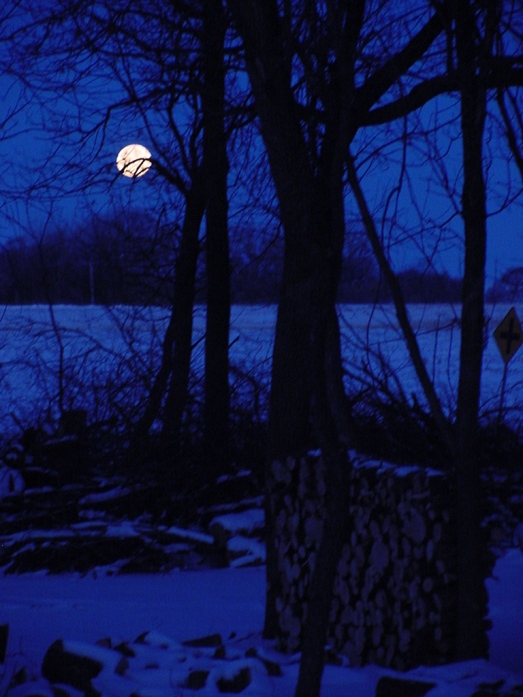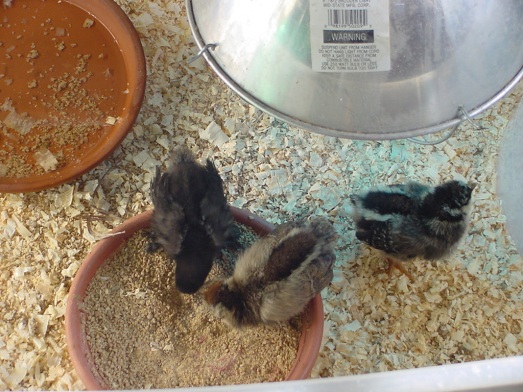In the early hours, a couple of Great Horned Owls were hooting across the grove as I headed down to the chicken coop to turn the lights on for the ladies. At -8 degrees, I won’t be opening the trapdoor for them today; they won’t walk out in the snow anyhow, so I might as well keep what heat they make inside and hopefully keep their eggs from freezing before I collect them.
A number of them have started laying now–little pullet eggs from the Silkies in a bed on the floor, and a deep brown “big girl” egg in a nesting box from who-knows-which hen. A couple of weeks ago I bought two dozen eggs from our food co-op, so we wouldn’t run out, but my girls keep filling up one side of that first carton so that we haven’t got to the second carton yet. Time for some holiday baking!
 It takes awhile for the coop light to warm up, and for it to be light enough in there for me to see (and not step on) the eggs–while it seems like the Silkies have decided on one particular corner to lay in, I’ve found eggs near the door and by the water fountain, too. I haven’t stepped on one yet, but I do have a horrible habit of sticking the eggs in my coat pockets and forgetting them by the time I’ve got inside the house. I haven’t broken one in my pocket yet, but it’s only a matter of time.
It takes awhile for the coop light to warm up, and for it to be light enough in there for me to see (and not step on) the eggs–while it seems like the Silkies have decided on one particular corner to lay in, I’ve found eggs near the door and by the water fountain, too. I haven’t stepped on one yet, but I do have a horrible habit of sticking the eggs in my coat pockets and forgetting them by the time I’ve got inside the house. I haven’t broken one in my pocket yet, but it’s only a matter of time.
Turns out I have two friends who’ve killed cell phones this way (and one with a long-forgotten rotten egg–blech!), and come to find out, their phones were killed by eggs from the same flock–the one friend having bequeathed his chickens to the other during a move. This makes me wonder if, during subsequent chicken adoptions, one should inquire into whether their eggs have killed [phones] before, and might be likely to kill again.
It’s solstice-time–the longest nights of the year–which means it’s also officially winter, though we’ve been suffering from the season’s bitter cold temperatures for a couple of weeks now. Monday was a heady reprieve–up above freezing and water trickling from the eaves. This morning, we took the below-zero temps with a modicum of good cheer because of the lovely hoarfrost.
 Not so cheery is the feral cat-who-thinks-she’s-a-chicken: A longer-term resident of this farm than us, she was raised around a previous flock, and if she had her druthers, I’m sure she’d be “cooped” up with her current batch of feathered friends. I don’t mind her milling about with them in the summer and scavenging in the compost for whatever they leave behind, but I don’t want to chance her stealing eggs or pooping in the coop.
Not so cheery is the feral cat-who-thinks-she’s-a-chicken: A longer-term resident of this farm than us, she was raised around a previous flock, and if she had her druthers, I’m sure she’d be “cooped” up with her current batch of feathered friends. I don’t mind her milling about with them in the summer and scavenging in the compost for whatever they leave behind, but I don’t want to chance her stealing eggs or pooping in the coop.
She has found a warm place to stay (when she’s not patrolling the barn or piles of buckthorn in the grove) between the basement windows we haven’t yet replaced–the outer one has a pane missing, and I’m sure we’re losing heat through there or she wouldn’t be hanging out. It’s driving the dog crazy to have a “foreign animal” so close to the house [practically IN it!–growls our vexed guardian], but Vega is smart enough not to stick her nose too close to a critter she knows is sharp.
John and I broke down on our no-feeding-feral-cats resolve, and I gave her a little dish of food this morning, which she gobbled like a champ once I moved a safe (by her reckoning) distance away. I am hoping so long as we put it out when she’s there and limit it to what she can eat in one gobbling, we’ll have less chance of attracting other, less desirable hangers-on about the place. Once the bitter cold has broken, she can find enough calories to keep warm through her own devices.
 Meanwhile, we’re wrapping presents, anticipating the arrival of our boys, and doing some cookie-baking and chili-making (OK, mostly John is). The long nights make us sleepy early, but we staved off the early-hour doldrums last night by attending the annual solstice fire at the farm of some friends, leaving the string of white lights on the porch railing plugged in to brighten our arrival home.
Meanwhile, we’re wrapping presents, anticipating the arrival of our boys, and doing some cookie-baking and chili-making (OK, mostly John is). The long nights make us sleepy early, but we staved off the early-hour doldrums last night by attending the annual solstice fire at the farm of some friends, leaving the string of white lights on the porch railing plugged in to brighten our arrival home.
The coincidence of the long nights, fullness of the moon, clear skies, and snow cover have also brightened our mood and provided plenty of opportunities for “mooning” about with our cameras both morning and night. John sets up his little bird blind in the yard some days to shoot images of the abundant visitors to the feeders, as well as tromping off to the various patches of prairie to catch the subtle light gleaming ’round clumps of Bluestem and Indian grass.
Me, I mostly stick close to home, freezing my fingers off for a few amateur shots around the farm.
 Happy Solstice, dear readers! May your winter nights be warm and full of love, and your coming year gentle and kind.
Happy Solstice, dear readers! May your winter nights be warm and full of love, and your coming year gentle and kind.









